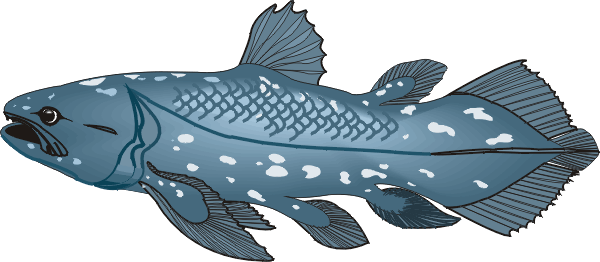A friend and colleague had recently challenged me to respond to Nova’s latest documentary on the Coelacanth. He kindly recorded it for me, only to find out later we ran out of tape half way through the show. (Doh!) He wanted to hear what I had to say on the “obvious evolution” of the Coelacanth.
 Not knowing what the claims were, I of course refrained from making any comments at all until I could at least see the transcript of the entire show. (BTW, the transcript is now available on line at http://www.pbs.org/wgbh/nova/transcripts/3003_fish.html)
Not knowing what the claims were, I of course refrained from making any comments at all until I could at least see the transcript of the entire show. (BTW, the transcript is now available on line at http://www.pbs.org/wgbh/nova/transcripts/3003_fish.html)
So when I finally did get to view the transcripts, it was the same-old, same-old. Rehashed and recycled claims, stated flatly as *fact*. Of course my buddy had questions! I have never had a problem with an honest evolutionist, and I appreciate my friend spurning me on (thanks Dam-O!). He later expressed regret over spurning the fire of Creationism (or was that “Ire”? :-), but really – what’s wrong with asking honest questions? Claims have been made, let’s examine them!
Now don’t get me wrong though – I love the Nova shows. I am merely trying to address the constant bombardment we see every day of evolutionary propaganda filtering down through virtually every facet of the media. Nova is no exception.
Evolutionary history:
It is believed that fish evolved into some land-walking mammal along the great evolutionary lineage. The Coelacanth had been suggested as a possible “intermediate”, a transitional life form mid-way between two stages on the evolutionary tree (as has also been claimed for many other fossil critters found over the years). Known only by its fossils which displayed “limb-like fins” it was thought extinct for at least 50 Million years until the dramatic, 1938 discovery of living Coelacanths.
As stated by J.L.B in the documentary:
“The Coelacanths have lived for probably 350 million years and in that time they have changed but little. ”
How about not at all. A Coelacanth has always been a Coelacanth. If you found the skeleton from a Chihuahua and a St. Bernard in fossil form, would you conclude they were the same species? Heck, let’s throw in a wiener dog and a bull dog for good measure! These are all the same species, yet the variation within the genetic code is quite amazing. I suggest the Coelacanth can express the same amount of diversity well within its genetic code…. and still be a Coelacanth.
However, this comment immediately brings up obvious questions. Why has it not changed in 400 Million years? Why did it evolve to that point so fast that we can’t even find it’s predecessor in the fossil record, but not any further? Has it really survived 50 Million years? (and don’t get me started on where they get those silly dates!)
By the way, what did it evolve into? We don’t find that in the fossil record either. If evolution had been going on for millions of years, I think it safe to say we’d find remnants of it. The best evidences are arguable at best, and are just as likely to be a unique life form as they are an intermediate.
Yes it is! No it isn’t! Yes it is!…
As one meanders through the show’s script in particular, you quickly see the schizophrenic attitudes portrayed by those wanting to figure out its evolutionary ascent. They want to believe it is an (if not *the*) ancestor to land mammals, but scientists cannot agree on whether it is or not.
The reasons quickly become obvious.
Fish have backbones, land animals have backbones, but the Coelacanth had “no real backbone”. It is described by the evolutionists themselves as having a “primitive backbone”, a soft, “gristly tube”. You need a backbone to walk on land. So what did this thing do? Devolve?
But there’s much more to the story.
Later on in the documentary, Daniel Robineau makes a remarkable statement, almost in passing. He mentions the presence of a “vestigial lung.” Now, please pardon my skepticism but this raises two red flags with me. First, if it’s a “vestigial” lung, that means it’s a leftover from its previous evolution. If it is the intermediate between a fish and a land mammal, why does it have the remnants of a lung? Isn’t it supposed to gaining a lung? (i.e. nascent)
Furthermore, this silly notion of vestigial organs has gone on for way too many years. Our former list of well over 100 “vestigial” organs in the human anatomy has dwindled to zero as over the years we have discovered what these organs did. I am quite confident that with further research, it will be found what this apparent “vestigial lung” is, and I’m going to venture a guess that it’ll have nothing to do with breathing air.
As if that wasn’t enough topsy-turvy evolution (I mean, c’mon – which way is it going? To the sea from land? To the land from sea?), Robin Stobbs mentions:
“The entire fish is filled with oil. There is not a single air sinus in the fish. So, like a diver’s depth gauge, it’s incomprehensible, which, in theory anyway, would allow it to swim at depths of 1000 meters or more.”
And one of the biggest reasons it hadn’t been found before was the depth at which it lives! It has NO inkling of heading to the shore! This fish was built for deep water! As was even stated in the documentary, it dies in shallow water due to the lack of oxygen content in the water.
Originally it was thought that these “limb like lobes” were evidence of a fish with the gear to walk. Surprise! These silly “limb-like lobes” are merely extra articulated fins which allow it to “hover” in the water. Gee, how very appropriate for a body which is neutrally buoyant and can move in any position in the water. Gee, what a good design! (Ooops – we’re not allowed to use the “D” word, especially in West Virginia 🙂
Fascinating, yes. Evidence for evolution? Nope.
I mean, puleeze – these people are suggesting that it fits into the evolutionary tree because it puts one fin forward at the same time it puts another backward? C’mon – that’s basic physics in action! The two actions cancel out giving the fish incredible control over which way it goes and how exactly it hovers. Think about it, it’s exactly the same reason you put your right arm forward with your left leg. This isn’t evidence of behavior passed on to us by our “ancient ancestor” the Coelacanth! It’s common sense!
Am I being too skeptical here?
Then there’s talk of it’s mammal-like reproduction. It’s like this fish is a strange patchwork of evolution and devolution combined. Maybe it’s just a unique fish? This fish is starting to sound as mixed up as the duck-billed platypus!
Assumptions as evidence
Unfortunately, I do hear a lot of assumptions promulgated as evidence. I hear it all the time and I honestly don’t think those making the claims really catch on to what they’re doing. For example,
“Their outward appearance has changed little, but internally, they must have adapted to changing environments as the Earth itself was transformed over time.”
Uh huh. Give me ONE good reason to believe that their internal organs have changed.
Is it because they have found fossils that show different internal structures in the fish? Nope.
There is only one reason to believe (or assume) such a statement: Evolutionary presupposition, which is not based at all on fact. If the outside of the fish hasn’t changed, I see absolutely no sane reason to believe the insides have changed. In fact, it appears that after hundreds of millions of years, just like the outside of the fish, the internal organs still haven’t changed.
The undiscovered ocean
I will, however, agree with their statements that the oceans are the most unexplored places on earth. Indeed, what other mysteries await us? If the Coelacanth, supposedly around for some “400 million years” and presumed extinct for the past 50 Million, suddenly turns up alive in entire schools – why not a marine dinosaur?
The skepticism of finding living, marine dinosaurs is justified, but not the cynical and snide remarks I have heard over the years. That is not science.
The Zuiyo Maru catch of a possible Plesiosaur off the coast of New Zealand in 1977 is tantalizing at the least. Now almost thirty years later, evidence is still coming to light and keeping alive the possibility that this was indeed a Plesiosaur. Recently, a second set of flippers on the dead carcass has been pointed out as refuting the possibility of it being a decaying basking shark. An article appeared in the Creation Science Research Quarterly on this.
Yet, the catch is still scoffed at by many. “It can’t be a Plesiosaur”, they say, “They’ve been extinct for millions of years!”
Hmmmm……



